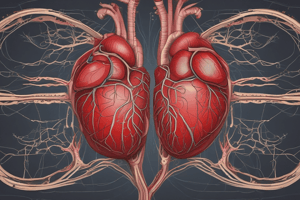Podcast
Questions and Answers
Which of the following heart chambers receives oxygen-rich blood from the lungs?
Which of the following heart chambers receives oxygen-rich blood from the lungs?
- Left atrium (correct)
- Left ventricle
- Right atrium
- Right ventricle
Which of the following is a characteristic of veins?
Which of the following is a characteristic of veins?
- Carry oxygen-rich blood under high pressure
- Have thicker walls to withstand pressure
- Often have a pulse due to the heart's contractions
- Have one-way valves to prevent backflow (correct)
What is the primary function of capillaries?
What is the primary function of capillaries?
- To regulate blood pressure
- To carry oxygen-rich blood to the body's tissues
- To exchange oxygen and nutrients with the body's tissues (correct)
- To carry oxygen-depleted blood back to the heart
Which of the following valves is located between the right ventricle and pulmonary artery?
Which of the following valves is located between the right ventricle and pulmonary artery?
Which of the following is a characteristic of arteries?
Which of the following is a characteristic of arteries?
Flashcards are hidden until you start studying
Study Notes
Heart Structure
- The heart is a muscular organ that pumps blood throughout the body
- It is divided into four chambers:
- Right atrium (upper right chamber): receives oxygen-depleted blood from the body
- Right ventricle (lower right chamber): pumps oxygen-depleted blood to the lungs
- Left atrium (upper left chamber): receives oxygen-rich blood from the lungs
- Left ventricle (lower left chamber): pumps oxygen-rich blood to the body
- The heart has four valves that control blood flow between the chambers:
- Tricuspid valve: between the right atrium and ventricle
- Pulmonary valve: between the right ventricle and pulmonary artery
- Mitral valve: between the left atrium and ventricle
- Aortic valve: between the left ventricle and aorta
Blood Vessel Types
- Arteries: carry oxygen-rich blood away from the heart to the rest of the body
- Elastic arteries: stretch to accommodate blood pressure changes (e.g., aorta)
- Muscular arteries: have thick muscle walls to regulate blood pressure (e.g., brachial artery)
- Distributive arteries: branch into smaller arteries to distribute blood to specific areas (e.g., coronary arteries)
- Veins: carry oxygen-depleted blood back to the heart
- Superficial veins: located near the surface of the skin (e.g., cephalic vein)
- Deep veins: located deeper in the body and often accompany arteries (e.g., femoral vein)
- Capillaries: tiny blood vessels where oxygen and nutrients are exchanged with the body's tissues
Artery Vs Vein Function
- Arteries:
- Carry oxygen-rich blood under high pressure
- Have thicker walls to withstand pressure
- Have smaller lumens (inner diameters) to maintain pressure
- Often have a pulse due to the heart's contractions
- Veins:
- Carry oxygen-depleted blood under low pressure
- Have thinner walls and larger lumens to accommodate blood flow
- Often have one-way valves to prevent backflow and ensure blood returns to the heart
- Do not have a pulse due to the low pressure
Studying That Suits You
Use AI to generate personalized quizzes and flashcards to suit your learning preferences.





